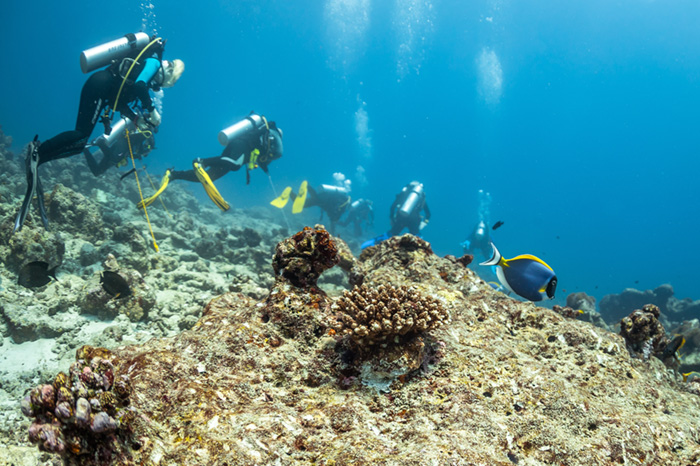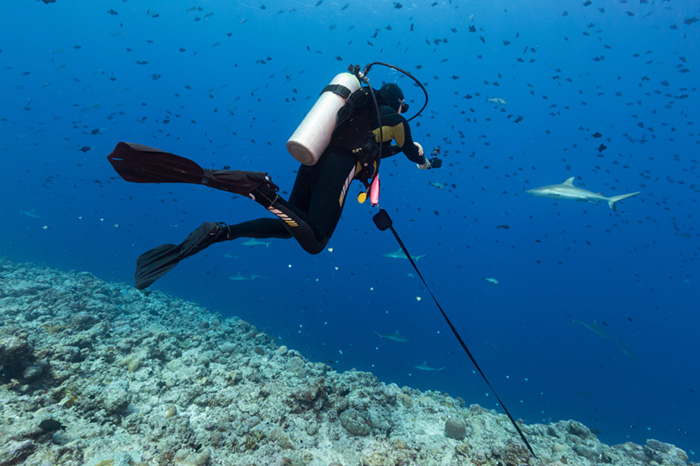Hook Me Up - Reef Hook Best Practices

What is your dream reef hook diving destination?
Reef hooks are a tool that scuba divers use to remain stationary in strong currents while diving. They are particularly useful when diving around coral reefs or other delicate ecosystems. They allow divers to stay in one place without accidentally damaging the reef or disturbing the local wildlife. In this article, we will explore reef hooks in more detail, including their uses, tips, and tricks for using them effectively and the best practices for ensuring that you use them safely and responsibly. We will also list popular liveaboard destinations where reef hooks are frequently used.
A reef hook is a metal hook designed to be anchored to the reef, allowing divers to attach themselves to a fixed point and remain stationary in strong currents. They are typically made of stainless steel and come in various sizes, depending on the reef's size and the current's strength. Reef hooks are not intended to be used as a permanent fixture on the reef and should only be used for short periods to allow divers to observe the surrounding environment without causing damage.
Why use a reef hook?
Reef hooks are particularly useful when diving in strong currents, as they allow divers to stay in one place without using excess energy or potentially damaging the surrounding ecosystem. They are also useful for photographers or videographers who want to capture images or footage of the local marine life without disturbing it. By using a reef hook, divers can remain stationary and observe the surrounding environment without impacting the reef or wildlife.
How does one use a reef hook?
Using a reef hook is relatively simple, but there are a few things to remember to ensure you use it effectively and responsibly. Here are the basic steps for using a reef hook:
1-Find a suitable location
Look for a spot on the reef suitable for anchoring a reef hook. This should be an area or rock that is away from delicate coral or other sensitive organisms and should be strong enough to withstand the force of the current.
2-Deploy the reef hook
Once you have found a suitable location, attach the reef hook to a secure point on the reef. Be sure to attach it to a sturdy piece of coral or rock, and avoid touching any delicate organisms or damaging the reef.
3-Attach yourself to the hook
Once the reef hook is securely anchored, attach yourself to it by clipping your safety line or another attachment point on your BCD. Be sure to use a strong and secure attachment point, and avoid putting too much weight on the hook or pulling too hard on the reef. Remember to attach the hook on the front and center of your body, or you'll be sideways, and you won't be comfortable.
4-Observe the environment
Once you are attached to the reef hook, take some time to observe the surrounding environment. Look for interesting marine life, and take photos or video footage if desired. Be sure to avoid touching or disturbing any of the wildlife, and always respect the surrounding ecosystem.
5-Remove the reef hook
Once you are ready to move on, pull yourself closer to the hook using the line and remove the reef hook by carefully unhooking it from its anchor point. Be sure to avoid touching any delicate organisms or damaging the reef.

Tips and tricks for using a reef hook
Here are some tips and tricks for using a reef hook effectively and responsibly:
-
Practice proper buoyancy control
Before using a reef hook, ensure you have good buoyancy control and maintain a stable position in the water without putting too much weight on the reef.
-
Choose a suitable location
Look for a location that is away from delicate organisms and is strong enough to withstand the force of the current.
-
Use a sturdy attachment point
When attaching yourself to the reef hook, use a sturdy attachment point that is strong enough to support your weight. Remember to attach the line to the center of your body so you face the right direction. Avoid putting too much weight on the hook or pulling too hard on the reef. This can cause damage to the surrounding ecosystem and potentially harm the wildlife that lives there.
-
Respect the local wildlife
When using a reef hook, it's important to respect the local wildlife and avoid touching or disturbing any animals. This will help ensure you don't accidentally harm the ecosystem or cause undue stress to wildlife.
-
Use the reef hook for short periods
Reef hooks should only be used for short periods, typically no more than a few minutes at a time. This will help to minimize any potential impact on the surrounding environment.
-
Practice responsible diving
Always follow responsible diving practices, such as not touching or removing any marine life, avoiding damaging the reef or other organisms, and not littering or leaving trash behind.
In conclusion, reef hooks are useful for scuba divers who want to remain stationary in strong currents while diving around coral reefs or other delicate ecosystems. By using a reef hook responsibly and following best practices for diving, divers can observe the local wildlife without causing any damage to the surrounding environment. If you are planning a liveaboard diving trip to a destination where reef hooks are commonly used, follow the guidelines outlined above to ensure that you use the tool effectively and responsibly.
Liveaboard destinations where reef hooks are frequently used
Reef hooks are frequently used on liveaboard diving trips to various destinations worldwide. Here are a few popular destinations where reef hooks are commonly used:
Raja Ampat, Indonesia
Raja Ampat is a popular diving destination in Indonesia known for its stunning coral reefs and diverse marine life. The strong currents in the area make it an ideal location for using a reef hook to stay stationary and observe the surrounding environment.
Palau, Micronesia
Palau is a remote location in the island nation of Micronesia, in the western Pacific, and is home to some of the world's most pristine coral reefs. The strong currents in the area can make diving challenging, but a reef hook can help divers stay in one place and observe the local wildlife without damaging the ecosystem.
Great Barrier Reef, Australia
The Great Barrier Reef is one of the world's most iconic diving destinations, known for its vibrant coral reefs and diverse marine life. The strong currents in Australia make it an ideal location for using a reef hook to stay in one place and observe the surrounding environment.
Galapagos Islands, Ecuador
The Galapagos Islands are a remote archipelago off the coast of Ecuador known for its unique and diverse wildlife. The strong currents in the area can make diving challenging, but a reef hook can help divers to stay in one place and observe the local marine life without causing any damage.










